Python
Female pythons lay eggs and defend them until they hatch.
Advertisement
Python Scientific Classification
Read our Complete Guide to Classification of Animals.
Python Conservation Status
Python Facts
- Prey
- Depends on species - rodents, birds, lizards, other snakes, monkeys, big cats, etc.
- Name Of Young
- Hatchling
- Group Behavior
- Solitary except during mating season
- Fun Fact
- Female pythons lay eggs and defend them until they hatch.
- Biggest Threat
- Habitat destruction and illegal pet trade
- Litter Size
- 3-30
- Diet for this Fish
- Omnivore
- Lifestyle
- Diurnal
- Nocturnal/Crepuscular
- Number Of Species
- 39
- Location
- Old World - Africa, Oceana, Australia, Asia
Python Physical Characteristics
- Color
- Brown
- Grey
- Yellow
- Fawn
- Red
- Blue
- Tan
- Albino
- Green
- Dark Brown
- Cream
- Chocolate
- Caramel
- Dull Olive
- Grey-Brown
- Golden
- Light-Brown
- Skin Type
- Scales
- Top Speed
- 1 mph
- Lifespan
- 20+ years, depending upon species
- Length
- 24 inches to 30 feet
- Age of Sexual Maturity
- 3-5 years
- Venomous
- No
- Aggression
- Medium
View all of the Python images!
Pythons are Old World snakes that inhabit a wide variety of habitats in Australia, Africa, Oceana, and Asia.
They’re nonvenomous and members of the Pythonidae family of snakes that constrict their prey with strong, muscular bodies. They’re popular as pets, and many species of these beautiful snakes are available from breeders, including ball pythons, reticulated pythons, and carpet pythons.
Amazing Facts About Pythons
- The longest python captured was a reticulated python that measured 26.25 feet long.
- They don’t crush their prey to death; instead, the pressure pythons exert when constricting their prey causes heart failure.
- Most arboreal pythons have longer teeth than terrestrial species. Scientists believe that this is so they can get through the feathers of the birds they often eat.
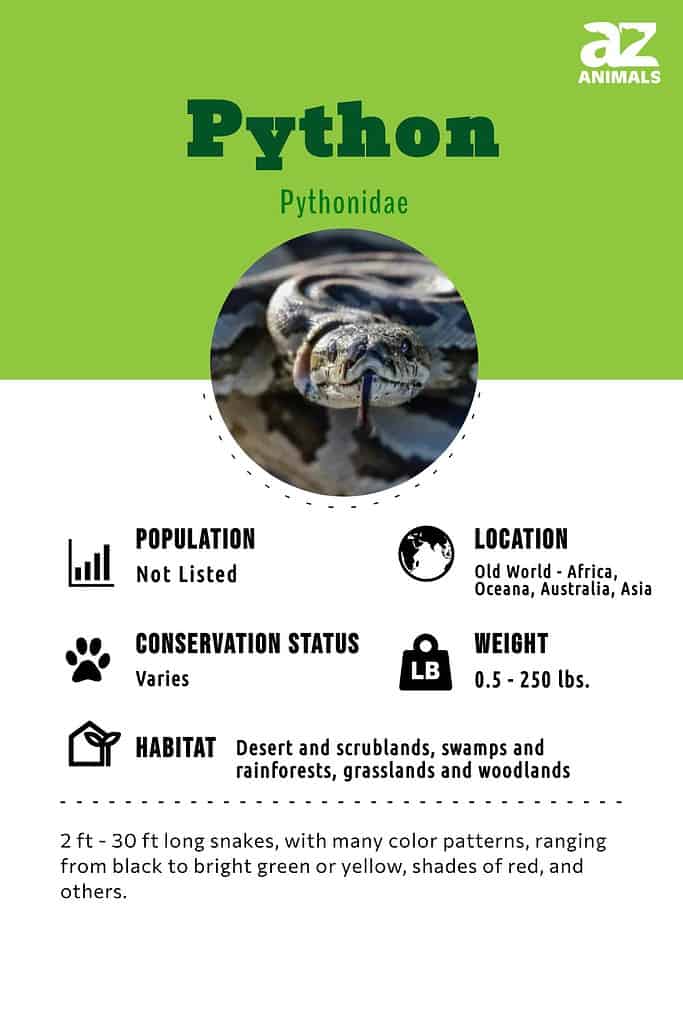
Where to Find Pythons
These are Old World snakes, meaning that they are not native to areas in the Americas, which are part of the New World. Instead, they make their homes in Africa, Australia, Oceana, and Asia. Habitats like rainforests, grasslands, woodlands, swamps, deserts, scrublands, and rocky terrain are home to over 40 species of python.
Some, like the Burmese python, have established breeding populations in countries outside their home range. These sometimes become invasive, crowding out native animals when they compete for the same prey items. This is true in Florida, where there they’ve had a breeding population since the 1990s.
These snakes can be active during the night or day; when they need to rest or digest they seek shelter in rocky outcrops, abandoned animal burrows, and in the branches or hollows of trees. However, there are a couple of exceptions to this. The woma and black-headed python dig their own burrows by scooping the dirt with their heads and curving their necks to drag it out of the hole. To keep dirt out of their mouths, the snakes’ lower jaws fit inside the upper jaws.
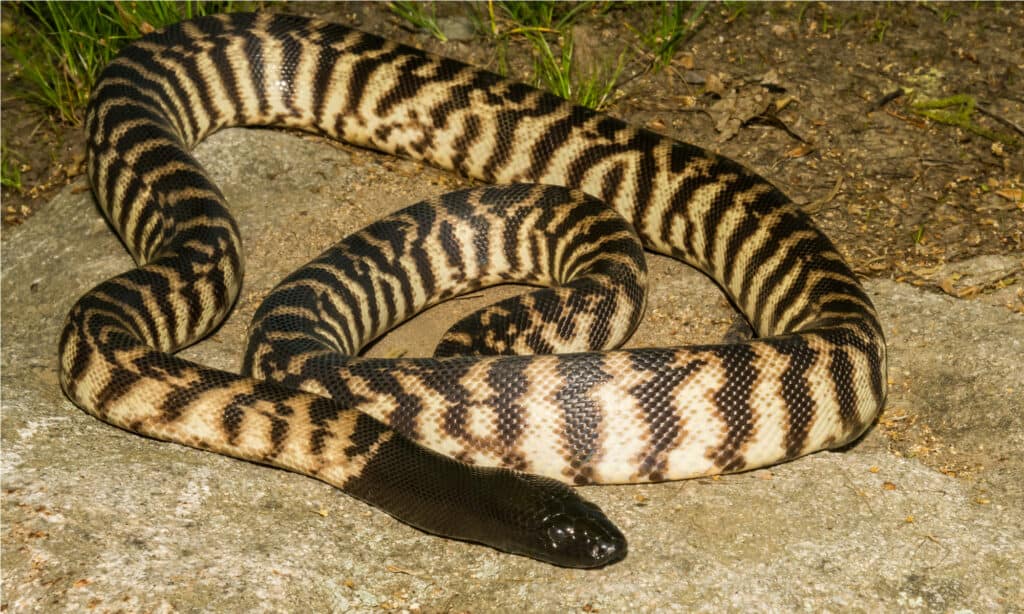
This species’ black head color sets it apart from others.
©Jay Ondreicka/Shutterstock.com
Diet and Feeding Habits
Most of these snakes are ambush predators, although some actively forage. Using their sight, smell, and heat-sensing pits along their lips, the snakes can even find their prey amid dense foliage in the dark. They have sharp teeth that they use to grab their prey, then quickly wrap their coils around it. Then, they squeeze until the animal’s heart stops.
They swallow their food whole, usually beginning at the head. Pythons have very flexible skulls, thanks to having extra joints; and skin that stretches to astounding lengths. Depending upon their size, these snakes eat a wide variety of animals. Anything from rodents and birds to lizards, monkeys, pigs, wallabies, or antelope may be included in their diet.
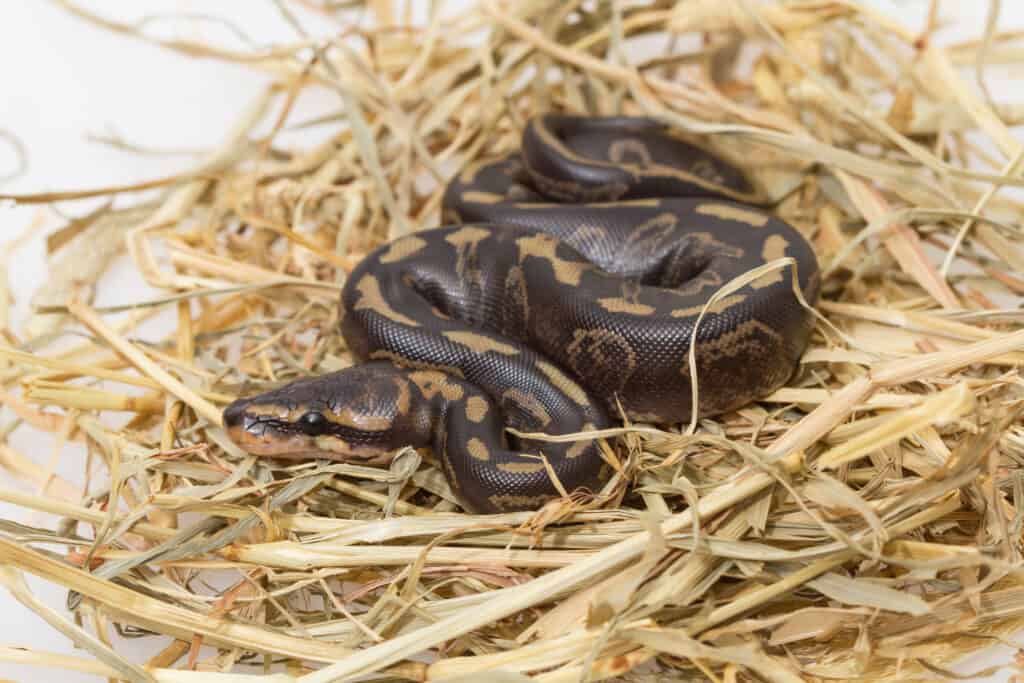
A black pastel ball python is black with cream or yellow spots.
©Bluedog Studio/Shutterstock.com
Scientific Name
Pythons were once classified in the same family as boas; and, while there are many similarities, there are also differences. In the early 2000s, genetic testing revealed that these Old World snake species were different from the boas – vastly.
In these prime examples of convergent evolution, where similar species evolve in very different parts of the world, two families of nonvenomous snakes evolved. One very big difference is that pythons are egg-layers, while boas give birth to live young. A second, but more subtle difference, is that a python’s heat-sensing pits are on its lip or labial scales, whereas a boa’s heat-sensing pits are between its labial scales.
The Pythonidae family name is a reference to the fabled serpent that the god Apollo killed in the founding of the Delphi temple of ancient Greek mythology. It has been used when referring to the monsters that inhabit the depths of dark, dank places. Python is sometimes loosely used to describe any very large snake.
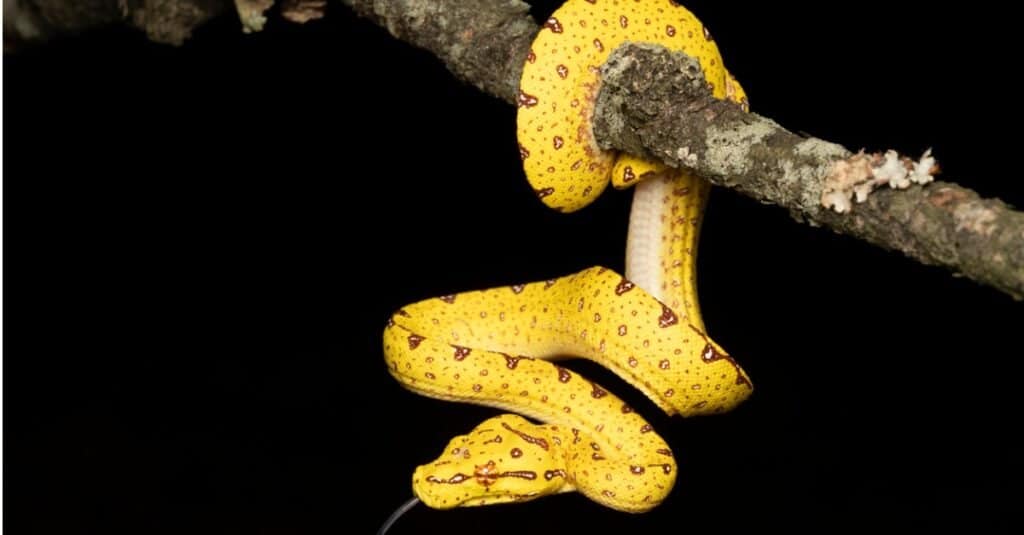
The
Pythonidaefamily name is a reference to the fabled serpent that the god Apollo killed.
©iStock.com/Mark Kostich
History and Evolution
Similar to other species of snake, pythons’ ancestors were actually legged reptiles, similar to lizards and reptiles that spent more time in and near water. As you might have guessed, they either lost their legs or they became vestigial, as they became more and more unused. It is interesting to imagine animals evolving to have legs and then evolving to lose them! There are benefits of being extremely low to the ground when your prey is on that level!
Pythons were previously classified with boas, but modern research has shown that the pythons and boas are separate species due to convergent evolution in different parts of the world, much like monkeys evolved differently in Africa and South America while having shared ancestors. Some of the major differences are that boas give birth to live young, and pythons lay eggs. Pythons also have their heat-sensing pits on their labial scales, and boas have them in between their labial scales.
Population and Conservation Status
Most python species are widely traded and bred as pets, so they aren’t in danger of going extinct. However, wild populations of some species (including ball pythons, and popular pets) are vulnerable to habitat loss and destruction, invasive species competing for resources, and hunting for skin and food.
According to the IUCN, most species are classified as least concern, but they rank a few species as near threatened, endangered, vulnerable, or data deficient. For example, the Oenpelli rock python, which lives in northern Australia, has fewer than 10,000 mature individuals in the wild.

Pythons are classified as least concern.
©Hand Robot/Shutterstock.com
Appearance and Description
Pythons can be nocturnal, diurnal, or crepuscular, depending on the species. They generally have triangular-shaped heads and many have heat-sensing pits along their lip. These snakes are considered primitive and still have vestigial hind limbs and pelvises. The vestigial limbs, called spurs are larger in the males and used during mating.
The snakes can be as small as 24 inches at maturity, as is the children’s python; and they can be as long as several yards, such as the reticulated python or the Oenpelli python. Ground-dwelling species are usually more muscular than their arboreal counterparts, but not always. Their size and bulk are dependent upon their environment and lifestyle.
Contrary to the myths you may have heard, these snakes do not launch themselves from trees to land on prey below them. Snakes, in general, are too delicate to handle that sort of behavior. Many arboreal pythons have prehensile tails, which they use to hang from branches or cave ceilings and snatch birds and bats as they fly by. Some species use their tail as a lure to attract prey to them. Many of these snakes live high up in the canopy of the forest, only occasionally coming down to the ground.
While two species of terrestrial (ground-dwelling) pythons dig their own burrows, most of these often use tree hollows and the abandoned burrows of other animals for shelter when they need to rest.
There are approximately 42 different species, all with different color patterns and size ranges. They range from black to bright green or yellow, shades of red, and a host of other colors.
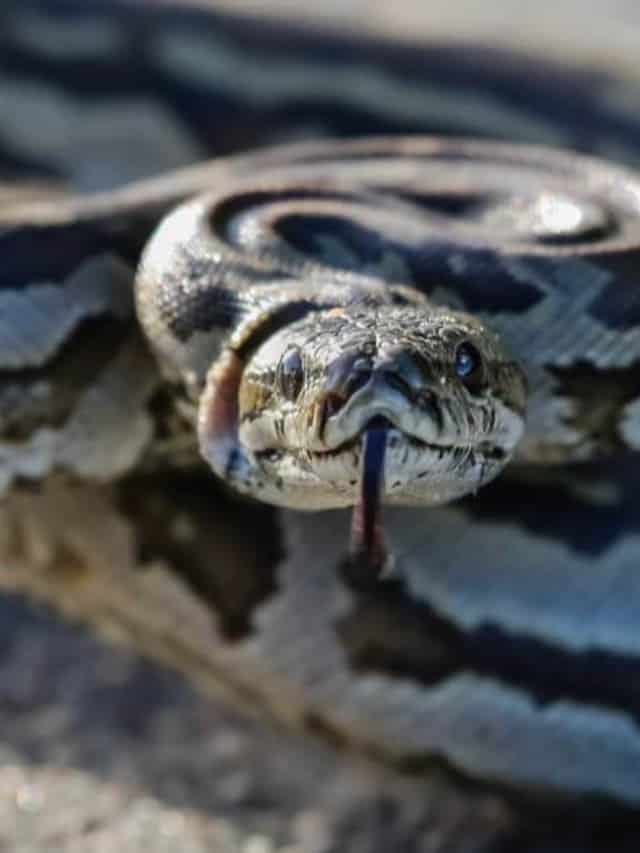
©iStock.com/Uwe-Bergwitz
Types
With over 40 species, Pythonidae is a diverse family. We’ve listed some of the most interesting or popular species here:
Antaresia
These snakes are all native to Australia and only reach about six feet long, at their longest.
Apodora
This monotypic genus (a genus only containing one species) is native to Papua New Guinea.
- Papuan olive python (A. papuana)
Aspidites
Another genus endemic to Australia, these are sometimes kept as pets.
Bothrochilus
This species is endemic to the Bismarck Archipelago and grows to a length of six feet.
- Bismarck ringed python (B. boa)
Leiopython
These species are native to New Guinea; they have also been observed regurgitating fur from their meals.
- D’Albert’s python (L. albertisii)
- Southern white-lipped python (L. fredparkeri)
Liasis
Snakes from the Liasis genus are native to Indonesia, New Guinea, and Australia.
- Macklot’s python (L. mackloti)
- Olive python (L. olivaceus)
- Savu python (L. mackloti savuensis)
- Water python (L. fuscus)
Malayopython
Native to India and Southeast Asia, there are two recognized species in the genus.
Morelia
Generally speaking, these snakes are arboreal or semi-arboreal and often more slender than other species.
- Carpet python (M. spilota) – this group of pythons includes several subspecies.
– Coastal carpet python (M. spilota mcdowelli)
– Diamond python (M. spilota spilota)
– Jungle carpet python (M. spilota cheynei) - Boelen’s python (M. boeleni)
- Bredl’s python (M. bredli)
- Green tree python (M. viridis)
- Rough-scaled python (M. carinata)
Nyctophilopython
Native to a tiny region in northern Australia, they’re slender and inhabit areas with rock outcrops for hiding.
Python
The “true pythons,” they’re native to areas in the tropics and subtropics in the Eastern Hemisphere.
- African rock python (P. sebae)
- Ball or Royal Python (P. regius)
- Burmese python (P. bivittatus)
- Blood python or Brongersma’s short-tailed python (P. brongersmai)
- Indian python (P. molurus)
- Myanmar short-tailed python (P. kyaiktiyo)
- Sumatran short-tailed python (P. curtus)
Simalia
Native to Indonesia, Australia, and Papua New Guinea.
- Amethystine python (S. amethistina)
- Moluccan python (S. clastolepis)
- Australian scrub python (S. kinghorni)
- Tanimbar python (S. nauta)
- Halmahera python (S. tracyae)
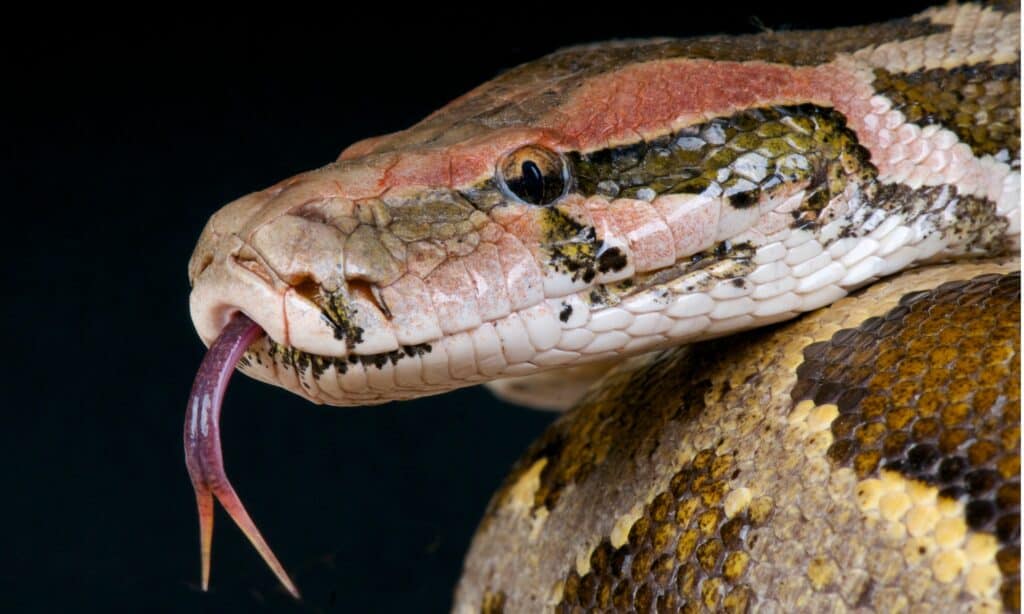
The Indian python is a large nonvenomous snake species found in India, Nepal, Pakistan, Sri Lanka, Bhutan, and Bangladesh.
©iStock.com/reptiles4all
How Dangerous are They?
Pythons aren’t venomous, so the only danger most people would encounter with one is an infected bite or a very cranky snake constricting them.
Larger species like reticulated and Burmese pythons can injure or kill people when they’re threatened. There are a few reports of reticulated pythons attacking people, according to an article in Proceedings of the National Academy of Sciences of the United States of America, but those are rare occurrences and usually the result of a snake being threatened by the individual who was attacked.
Behavior and Humans
In the wild, pythons generally avoid people. Those kept as pets become accustomed to interacting with people, and often become quite docile. Some even seem to enjoy the interaction. Many of these species make great pet snakes – they’re beautiful and typically easy to handle with a little practice. Larger species, like Burmese and reticulated pythons, should only be kept by people who have experience with big snakes, and most require an additional person to help handle the really big ones.
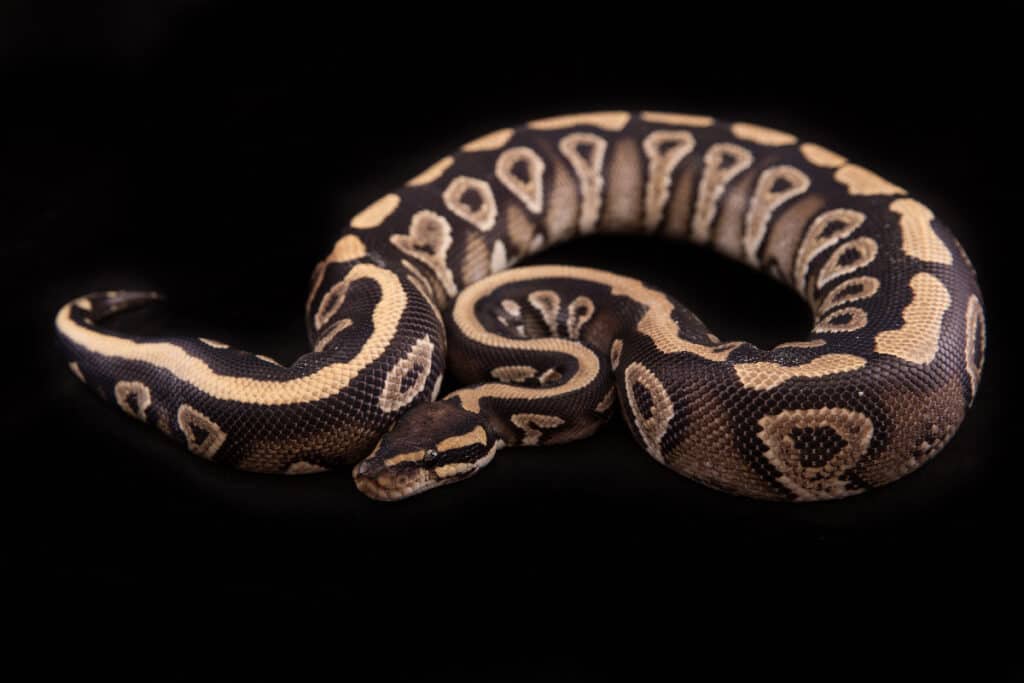
Ball pythons are popular pets.
©Sanne Romijn Fotografie/Shutterstock.com
These snakes help keep ecosystems in balance, and although people often keep them as pets, ideally we should only bring home captive-bred individuals; it would allow some of the wild populations to recover from over-harvesting for the pet trade.
View all 192 animals that start with PPython FAQs (Frequently Asked Questions)
Where do pythons live?
These are Old World snakes, meaning they are native to Africa, Asia, Oceana, and Australia. Even though you can find Burmese Pythons in Florida, they didn’t evolve there.
What do pythons eat?
These snakes have a pretty wide variety in their diet, even though it’s all meat. They’re obligate carnivores, which means they only eat meat. Almost all of them eat rodents and lizards when they’re small; while some graduate to larger prey as they grow, such as rabbits, pigs, monkeys, and more.
How do they hunt?
These are ambush predators. Some will actively forage for prey, but most hang out, camouflaged, while they wait for their food to show up.
Are pythons dangerous?
Bigger specimens can be dangerous; a reticulated python can get really big – 20+ feet sometimes. Otherwise, they’re not all that dangerous because they aren’t venomous.
Thank you for reading! Have some feedback for us? Contact the AZ Animals editorial team.
Sources
- Pythons | San Diego Zoo, Available here: https://animals.sandiegozoo.org/animals/python
- Ball Python | Reptile Database, Available here: https://reptile-database.reptarium.cz/species?genus=Python&species=regius&search_param=%28%28taxon%3D%27pythonidae%27%29%29
- Headland, Thomas N. and Harry W. Greene; Hunter–gatherers and other primates as prey, predators, and competitors of snakes | PNAS, Available here: https://www.pnas.org/doi/full/10.1073/pnas.1115116108

















